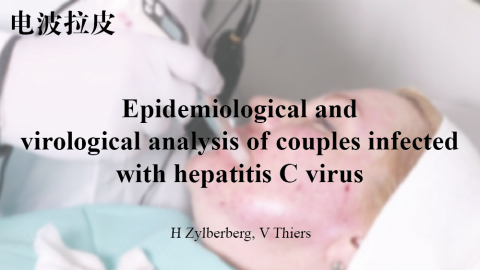
- 3545人
- 分享收藏
Epidemiological and virological analysis of couples infected with hepatitis C virus
H Zylberberg, V Thiers
简介
【 文献重点摘要 】
Background
If transmission of hepatitis C virus (HCV) infection through parenteral exposure is well documented, sexual transmission of HCV is still debated.
Aims
To perform extensive epidemiological and virological analysis in 24 couples in which each spouse was anti-HCV positive in order to delineate more precisely potential sexual transmission of HCV.
Patients
Twenty four couples in which each partner was anti-HCV positive. These 48 spouses were recruited in a liver unit by regular screening of spouses of index patients.
Methods
All 48 spouses completed an epidemiological questionnaire on risk factors for HCV. Qualitative detection of serum HCV RNA and determination of HCV type by genotyping and serotyping were performed. Sequence analysis of HCV strains by phylogenetic analysis was carried out in seven couples with concordant genotypes.
Results
The mean (SD) partnership duration was 12 (10) years. Serum HCV RNA was detected in both partners in 18 of the couples (75%) and in only one partner in six of the couples (25%). HCV typing showed concordant genotypes in 12 couples (50%), discordant genotypes in seven (29%), and in the other five couples (21%) only one spouse could be genotyped. Of the 48 spouses, 33 had a major risk factor for HCV transmission such as transfusion (n = 6) and intravenous drug use (n = 27). Eleven of the 12 couples infected with the same HCV genotype had at least one parenteral risk factor for viral transmission in both spouses. Whatever the genotype concordance, in most couples (75%), both spouses showed parenteral risk factors for viral transmission. Sequence analysis of HCV strains was possible in seven of 12 couples with identical genotype and showed different and identical isolates in four and three couples respectively.
Conclusion
The study emphasises the risk of overestimating the importance of a very low sexual HCV transmission risk as against other, mainly parenteral, risk factors.
背景
如果通过肠道外暴露传播丙型肝炎病毒(HCV)是有很好的证据的,那么HCV的性传播仍然是有争议的。
目的
对配偶均为抗-HCV阳性的24对夫妇进行广泛的流行病学和病毒学分析,以便更准确地勾勒出HCV潜在的性传播。
患者
24对夫妻均抗-HCV阳性。这48名配偶是在一个肝脏单位通过定期筛查指标患者的配偶招募的。
方法
48例配偶全部完成HCV危险因素流行病学调查。对血清HCVRNA进行定性检测,并通过基因分型和血清学分型进行HCV分型。对7对基因型一致的夫妇进行了丙型肝炎病毒(HCV)毒株的系统发育分析。
结果
平均合伙时间(SD)为12(10)年。在18对夫妇(75%)的两对伴侣中都检测到了血清HCVRNA,而在6对夫妇中只有一对伴侣(25%)检测到了血清HCVRNA。HCV分型结果显示,12对夫妇(50%)基因型一致,7对(29%)基因型不一致,另外5对夫妇(21%)只有一对配偶可以分型。在48名配偶中,33名有HCV传播的主要危险因素,如输血(n=6)和静脉吸毒(n=27)。在感染相同HCV基因型的12对夫妇中,有11对在配偶双方中至少有一个病毒传播的非肠道危险因素。无论基因型的一致性如何,在大多数夫妇(75%)中,配偶双方都显示出病毒传播的非肠道危险因素。在12对基因型相同的夫妇中,有7对可以进行HCV毒株的序列分析,在4对和3对夫妇中分别显示了不同和相同的分离株。
结论
该研究强调了相对于其他危险因素(主要是非肠道危险因素)而言,高估非常低的性传播HCV风险的风险。



